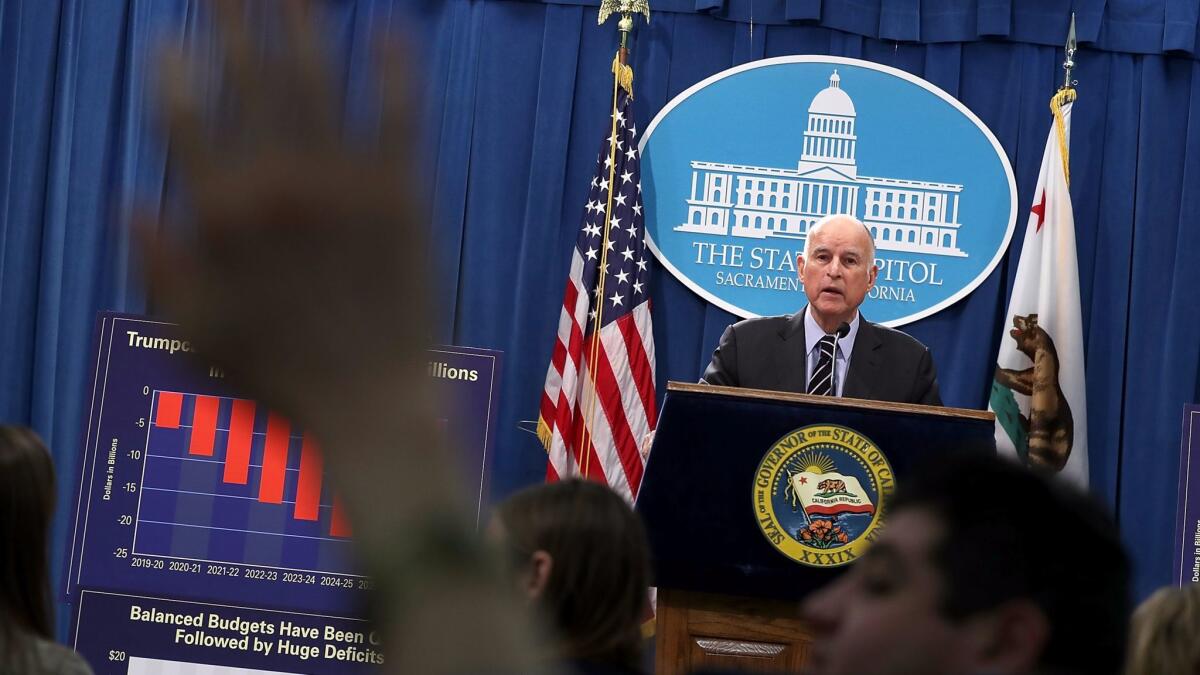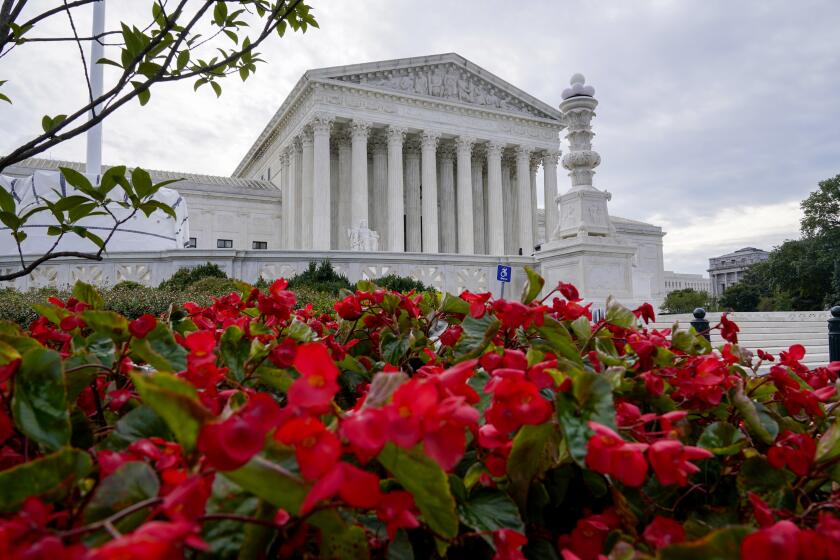Gov. Jerry Brown urges Republican ‘penance’ for healthcare vote, warns of the impact on California’s budget

- Share via
Sacramento — Gov. Jerry Brown on Thursday presented a slightly sunnier view of California’s economy than he offered just four months ago, but nonetheless delivered one of his vintage sermons on the evils of overspending when outlining a new state spending plan.
And this time, the man who once trained to be a Jesuit priest singled out the state’s Republican members of the House for their unanimous vote to repeal the Affordable Care Act — a move that alone would result in California losing $18.6 billion in federal funds a decade from now.
“They weren’t sent to Congress just to take orders from that crowd, or from Donald Trump,” Brown said. “I think they made a mistake, and they’re going to have to do penance for it.”
The $183.4-billion spending plan, revised from his first version in January, does not assume any actual loss of federal dollars, given that Congress remains divided over a number of issues on how to rework the Obamacare law. Nor does it offer any assurances that the state has a “plan B” should it come to pass. Brown has insisted that detailed plans must emerge in Washington before the state changes course.
What the new spending outline does do, though, is offer a handful of concessions to lawmakers, local governments and advocacy groups that had criticized Brown’s earlier budget proposal as too meager. The governor abandoned his call to delay expansion of full-day preschool and higher payments for child care providers. He also agreed to expand dental benefits for low-income adults, and reversed a decision to fully transfer a new healthcare delivery system to county governments.
Counties had been particularly vocal about Brown’s winter healthcare proposal, which would have cut annual state spending by $600 million on a program that seeks to streamline the use of medical and in-home support services by seniors and disabled citizens. Instead, the state will gradually reduce its subsidy over a four-year period.
“We think we’ll be able to avoid significant cuts to vital county services as a result of the infusion of cash,” said Matt Cate, executive director of the California State Assn. of Counties.
The updated spending plan also, at first blush, offers good news for K-12 education. Under the long-standing constitutional guarantee, schools are generally promised more money when tax revenues rise. The governor proposes $1.4 billion more in general fund spending than he did in January. He also has dropped his effort to use future education dollars to pay current obligations, a complicated plan strongly opposed by education advocates.
But Brown’s new budget seeks to trim future school spending. “We wouldn’t be growing as fast as the rest of the budget under this plan,” said Kevin Gordon, a longtime education lobbyist.
The new budget is likely to raise eyebrows, too, at the University of California, where Brown proposes tying $50 million in funding to recent promises on accepting more transfer students as well as recommendations made in the recent audit of UC President Janet Napolitano’s office operations.
Political Road Map: California has $55 billion in tax breaks on the books, many here to stay »
That the governor can offer more money to a variety of programs is a sign that he and his advisors now believe their original economic projections were too conservative. In fact, completely missing from the governor’s question-and-answer session with reporters on Thursday was one of his most dire warnings in the first budget: a projected deficit of $1.6 billion.
Only later did his budget director, Michael Cohen, confirm that the new projected shortfall — absent any action to prevent it — would be only $400 million in the coming fiscal year. The change is driven by substantially higher estimates of personal income tax collections in the coming budget year, offset by weaker-than-assumed tax receipts for a time period that stretches back the summer of 2015. State budget writers generally use a three-year view of revenue collections to craft, and revise, California’s spending plan.
While the governor backed down on some of his preferred spending constraints, he held fast on others. Perhaps most contentious of those is Brown’s broad interpretation of the rules governing last year’s tobacco tax increase, Proposition 56.
Advocates believe that revenue from the new $2-per-pack tax is supposed to go to increasing access to Medi-Cal, the state’s healthcare program for the poor, and raising the low reimbursement rates paid to Medi-Cal providers. The governor, on the other hand, is calling for that money to be used to maintain existing program levels.
“I think the voters voted in good faith, thinking that the money would be there,” Assembly Speaker Anthony Rendon (D-Paramount) said in an interview with The Times’ Sacramento bureau this week.
While the majority of the new spending plan represented tweaks or modifications of existing ideas, Brown introduced one notable and unique idea on Thursday when it comes to the state’s daunting obligation to pay for public employee pensions. In essence, the state would tap an internal government fund to make a one-time $6-billion payment to the California Public Employees’ Retirement System (CalPERS).
The money would effectively double the total size of the state’s contribution to the pension fund next year, and budget writers believe it could slightly ease the state’s obligation in future years to make rapidly rising annual payments for retirement promises made to government workers. The money would be a loan from the internal fund, and the debt would be paid back in part with money set aside in California’s newly expanded rainy-day fund.
Even with the proposals outlined Thursday, Brown insisted the state’s financial future remains unclear. And he offered a particularly sharp critique of the president and Republicans in Congress for changes that could send shockwaves westward.
The governor, standing beside a poster board emblazoned with the word “Trumpcare” and projecting multibillion-dollar healthcare cuts to California, also took aim at the wisdom of the president’s tax cut ideas.
“We don’t want a Trump tax program that exacerbates the growing disparity, and income gap, that is undermining American society,” he said.
Times staff writer Melanie Mason contributed to this report
Follow @johnmyers on Twitter, sign up for our daily Essential Politics newsletter and listen to the weekly California Politics Podcast
ALSO:
Political Road Map: Does the state spend more money on schools or prisons?
Brown’s state budget dominance starts with a firm grip on revenue predictions
Updates on California politics and state government
More to Read
Get the L.A. Times Politics newsletter
Deeply reported insights into legislation, politics and policy from Sacramento, Washington and beyond. In your inbox twice per week.
You may occasionally receive promotional content from the Los Angeles Times.











